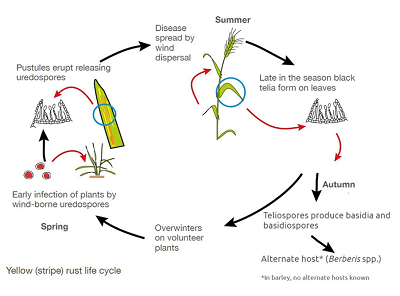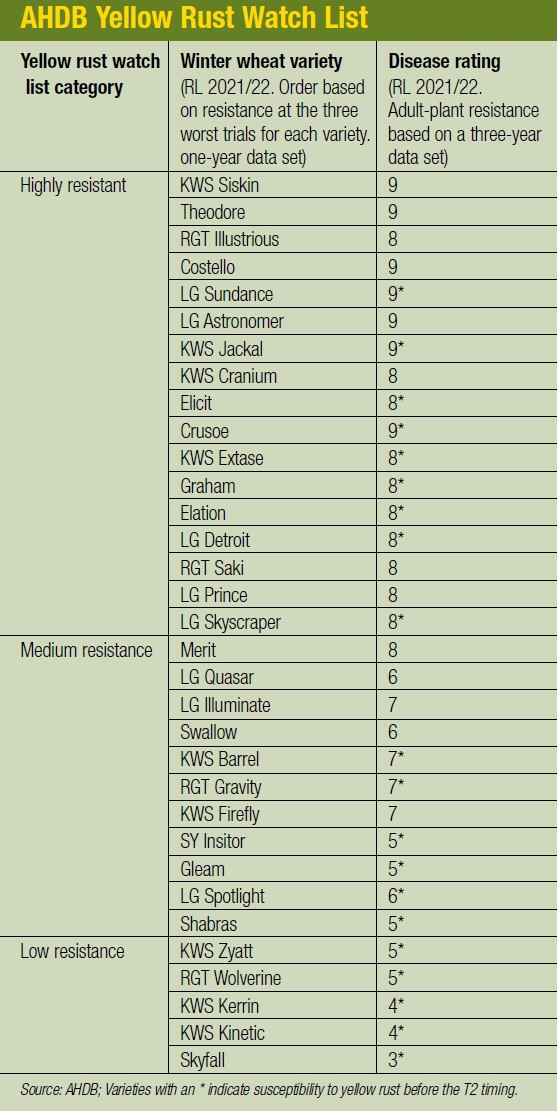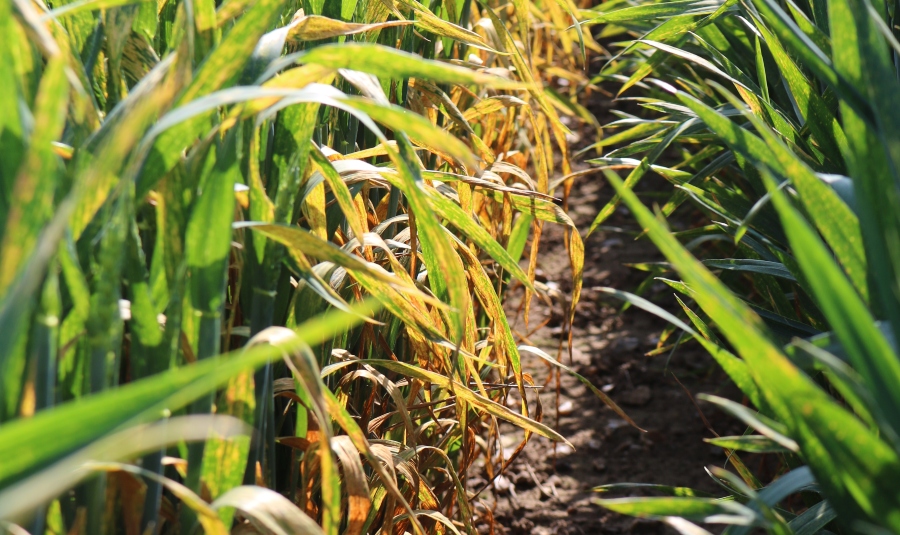In a year when disease levels were low, yellow rust stood out as the one to watch in 2020. CPM takes a look at the changing picture of a problem pathogen.
You have to think about yellow rust all the time, even if you have a variety that is supposedly resistant.
By Mike Abram
The yellow rust jungle drums are already beating, as agronomists and growers start to publish pictures on social media of the disease infecting wheat crops again.
The list of varieties where it has been seen include the obvious, such as Skyfall rated as a three now on the AHDB Recommended List, and one of the varieties worst hit last season to the less obvious, such as KWS Extase, rated an eight.
Other varieties where it has been found in January include RGT Gravity, LG Skyscraper, Graham and KWS Barrel. All of those varieties have one thing in common – they have good adult plant resistance but are susceptible as young plants.

The yellow rust life cycle; * there’s no known alternate host in barley; Sexual stage of the life cycle does not occur in the UK on Berberis; Source: AHDB.
It’s one of the things that can make yellow rust a bit trickier to control: will adult plant resistance kick in and diminish its threat? Or is it a sign that the adult resistance has been broken and a new race is about to overrun the variety?
While this remains an in-season dilemma for growers, the advice is clear on one aspect — that this is a dynamic situation. The arrival of the Warrior group of races across Europe in 2011, believed to come from the Himalayas, may be a key reason behind the change. They are thought to be derived via sexual recombination rather than asexual mutation as the UK population had previously been, and this has led to high diversity within the population.
As a result, the yellow rust varietal resistance ratings have been changing more than normal as these Warrior races battle for supremacy, says Bill Clark, technical director for NIAB. “And that’s still going on – we can still expect yellow rust ratings to be dynamic.”
While the original Warrior or Pink group race found early success, the other races slowly built up through varietal selection. Most of the rust population now is from the Warrior minus or Red group of races, which has become dominant, although additional races arrived in the form of the Kranich (Purple 3) and Blue 7 races.
In 2019, the UK Cereal Pathogen Virulence Survey (UKCPVS) found a new isolate, part of the Warrior minus (Red group), Red27 was responsible for the unusual outbreak on KWS Zyatt and Dunston.
And perhaps in a forerunner to what happened in the field in 2020, five isolates collected in 2019 then displayed virulence against new combinations of yellow rust resistance genes were investigated by UKCPVS in adult plant trials in the spring of 2020. All five infected KWS Firefly, which may explain the outbreak in that variety last season.
“Things have clearly changed again,” Bill says, with the latest results from UKCPVS due to be published in March.
The rapidly changing picture has created challenges for the RL ratings, which used to be based on the average of the previous three seasons’ results, says Matt Bull, Syngenta seeds technical expert.
“AHDB has recognised the adult plant resistance ratings didn’t reflect any changes quickly enough.”

The latest AHDB RL yellow rust resistance ratings now use a weighted score, with the previous season’s results three times more important than results from three seasons ago, he explains. “The resistance rating is based more on the latest year.”
In addition, there’s been a resetting of how much disease is equivalent to a particular rating. Over time this had gradually changed so that 10% yellow rust on a variety in 2019 would have meant a rating of 5, while in 2012 it would have meant a rating of 4.
For the new RL it has been reset to the 2012 level, which has led to greater discrimination between varieties on the list, says Matt.
The AHDB has also released a yellow rust watch list (see table on pxx), which orders varieties based on disease levels in the three worst trials for each variety, to allow easy comparison with the ratings on the RL. “It will help warn about what changes we might expect in varieties in future – an early warning system.”
With such a dynamic situation, it makes crop walking crucial, says Mike Thornton, head of crop protection at Procam. “You have to think about yellow rust all the time, even if you have a variety that is supposedly resistant.”
Resistance ratings are useful as a starting point, but while the ratings for other diseases don’t shift much or, if they do, in a smaller way, there is potential for changes to happen within a field quickly with rusts, he says.
“It’s a disease that requires more on-the-ground emphasis.”
That extends to not over-thinking juvenile resistance, Bill says. “You don’t know when the adult plant resistance will kick in. It is not unusual to see yellow rust on varieties at the T1 timing, when those varieties are rated as nine on the Recommended List.
“From an advisory point of view it’s simple: if you see yellow rust in the crop and it’s clearly active, not just the odd fleck, then you have to treat the variety as if it‘s susceptible.”
That’s not just because adult plant resistance is not always reliable in terms of a new race overcoming the variety’s genetic resistance, but also because it might not kick in in some varieties until as late as flag leaf emergence, he says.
“You cannot wait and wait, expecting the variety to show its adult plant resistance. You might have already missed two opportunities to treat.”
Timing is everything with controlling the disease, he stresses. “You must get on top of yellow rust early in the season. If it gets away from you, you will be chasing it all season. For growers who see it early in the season, T0s are critical.”
That’s not only to control infection at that time, but also to give leeway in timing T1 sprays. “If it turns into a wet spring and you can’t get on with your T1, you’ll regret not having put a T0 triazole on. At T0 most people would use a tebuconazole, as it’s very cheap and effective.”
At T1, Mike advises growers to look for products that are both potent and persistent, especially with epoxiconazole-based products on use-up and what he suspects were limited forward sales for the coming season. “Timings can be stretched, not by design, because of weather, and also through farm size and different holdings, so you need to be adequately protected. Solatenol fits that pretty well – there is nothing better on rusts.”
Bill agrees that Elatus Era’s (benzovindiflupyr+ prothioconazole) strength is for rusts at T1. “If you’re in a yellow rust area, growing any of these susceptible varieties, it’s a very strong rust product, has a position for those who have rust as a problem and is good on septoria as well.”
With a wide range of drilling dates, as well as a relatively mild autumn and early winter, yellow rust looks like being threat again this season.
“There’s more wheat in the ground, and a bigger proportion of that is in better condition than last season,” Mike says. “Crops haven’t sat in water, so have been taking up nutrition and have better root structures, and fewer have been under stress.
“It’s been mild so that will counter that to some degree, and you can find the disease in some crops, but I think the pressure will be less.”
Early drilled crops might be carrying higher levels of disease, Matt points out. “But the later drilled crops, sown at the end of last year after the wet October delayed drilling for some, will be in juvenile stages for longer in the spring, which is when the yellow rust epidemic generally takes off. That could render them more susceptible and at greater risk.
“With backward or later drilled crops it’s also imperative to maintain green leaf area as much as possible to protect yield.
“So it will be important to monitor both early and late drilled crops for yellow rust,” he says.
And growers should be on their guard for yellow rust, Bill stresses. “All of the old European races have all been pushed out by these new Warrior populations. They are much more severe than we used to get, and are very well adapted to the UK climate. Don’t underestimate the threat they pose,” he concludes.
What about brown rust?
The brown rust population appears to be much more stable than yellow rust, with generally wheat varieties behaving as you would expect from their ratings on the AHDB Recommended List.
Compared with yellow rust, where temperatures of 10-15°C are ideal for spore germination, infection and spread, brown rust prefers higher temperatures of 15-22°C. Not surprisingly, that means it tends to be a disease of mid-to-late summer, and more prevalent in the south and east of England.
“It’s a big issue on a small number of varieties, such as Crusoe, Firefly sometimes,” says Bill.
Only after very mild winters with warm springs do you see brown rust threaten much before flag leaf timing, he notes. “It’s very rare. A usual winter with some frosts will mean any brown rust on crops in autumn will disappear and only reappear later in the season.”
Control is straightforward, he says. “It’s not a difficult disease to control. SDHIs, azoles, strobilurins – there are a lot of options to control brown rust, and it will normally be taken care of by your standard programme.”
Disease ratings are more reliable with brown rust, notes Mike. “The variety in my region in the south to watch for is Crusoe, which is well-known to be susceptible. But if you get your timing right, it’s easily controlled.”
He would usually rely on his SDHI choice at T2 to provide control of brown rust, with azole options, such as tebuconazole, metconazole as options for T3.
Matt recommends using Elatus Era at T2 where brown rust is likely to be a problem, noting it’s the most effective SDHI/azole product for the disease.
Brown rust high risk factors
- Susceptible varieties
- Early drilling
- Mild winter
- Hot, humid weather, especially April to July
- Southern regions of the UK
- Volunteers of same crop that provide a green bridge
- Source: AHDB
High risk factors for yellow rust
- Susceptible varieties
- Eastern regions of the UK
- Green bridge from previous crop
- Cool, damp weather
- Mild winter
- Humid microclimate
Source: AHDB
Disease delve – rusts
Knowing your enemy is the first line of defence against disease – stay a step ahead and you maintain better control. But when it comes to key cereal diseases, it’s an evolving picture – the pathogen itself is mutating, research moves on apace and our understanding of the dynamics changes with every season.
To bring this picture into perspective, CPM has teamed up with Syngenta to take a deep dive into the key cereal diseases. Looking at septoria, rusts and the major pathogens in barley, these articles will explore the latest knowledge and deliver insight on cutting-edge research to bring growers bang up to date – it’s much easier to manage a problem if you know more about it.
With its unpredictability, it’s clear yellow rust needs tackling decisively. Which is why Elatus Era fits so well. Its potent SDHI, solatenol (also called benzovindiflupyr), is well-recognised for dealing rust, as well as Septoria tritici, a powerful blow. Optimum timing in yellow rust situations is typically T1. Against brown rust, it is typically T2.




